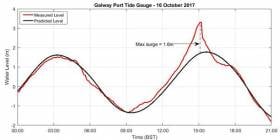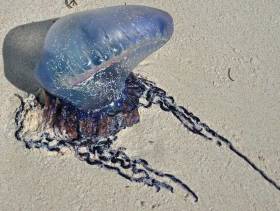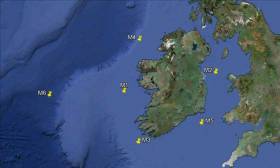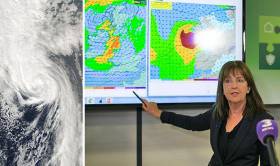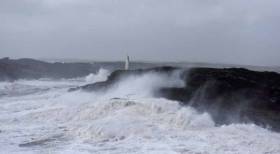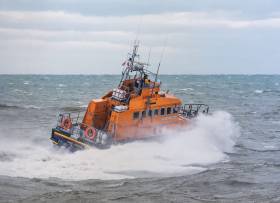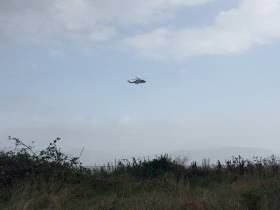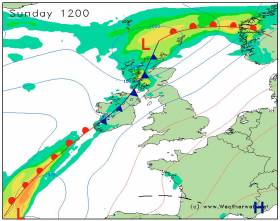Displaying items by tag: Ophelia
Ophelia: Crunching The Numbers On Galway’s ‘Unusual’ Storm Surge
#Ophelia - With most of Ireland battening down the hatches for the second time in a week in preparation for Storm Brian’s arrival, the Marine Institute in Galway says it continues to gather and analyse data from Storm Ophelia.
Despite Galway escaping much of the worst of the wind damage associated with Monday’s storm, a short-lived but notable surge of 1.6m just after 3pm resulted in flooding in a number of well-known locations across the city.
Storm surges occur when strong winds ‘push’ water up against a coastline and low atmospheric pressure associated with a weather system such as Ophelia raise the sea surface further.
Surges in the sea level, measured by the Irish National Tide Gauge Network, were seen around the Irish coast. But the timing of the storm passing over Galway with its associated peak in wind speed coincided with the approach of high tide, resulting in flooding at the Docks, Spanish Arch and Salthill Promenade.
What was unusual was how quickly the surge dissipated, the Marine Institute adds, noting that the predicted high tide occurred just 30 minutes after the peak surge, but the surge itself had dropped by 1.25m to only 35cm in that time.
The unusual nature of the surge can most likely be explained by a rapid change in direction and speed of the wind field in Galway Bay but further investigation is required to understand the event fully.
As previously reported on Afloat.ie, the Irish Marine Weather Buoy Network recorded a record sixty-foot wave off the South East Coast on Monday afternoon before the M5 buoy broke from its moorings.
Among those feeling the effects in the water was Dingle's resident dolphin Fungie, who was found to have a number of serious cuts on his body during the week – though as Buzz.ie reports, he's expected to make a full recovery.
Elsewhere, Michael Viney writes in The Irish Times how Storm Ophelia's advance on Ireland stumped a key resource for Ireland's big wave surfers – one of whom has defended his decision to ride the storm-powered swell off Killiney in Co Dublin to TheJournal.ie.
Ophelia: Coastal Caution Advised Over Portuguese Man O’War Sightings
#Ophelia - Storm Ophelia may have brought on a repeat of last year’s infestation of Portuguese men o’war, an Irish zoologist has warned.
As The Irish Times reports, Dr Tom Doyle of NUI Galway is appealing for caution along Ireland’s coastline after isolated reports of strandings of the tropical marine creature, which packs a potentially lethal sting,
“The southerly winds we had during Ophelia will have swept many up from the Bay of Biscay area, but as yet we have not received many specific reports,” said Dr Doyle.
The days preceding Storm Ophelia’s arrival saw a spike in sightings, he noted, with up to 200 counted as of this morning (Wednesday 18 October).
They are not the only marine wildlife that have washed up on Irish shores with the violent impact of Monday’s hurricane-force winds, as Karin Dubsky of Coastwacth says large numbers of shellfish and octopuses have been beached around the coast.
The Irish Times has more on the story HERE.
Sixty–Foot Record Wave Recorded During Hurricane Ophelia
Record wave heights were captured by the Irish Weather Buoy Network during Hurricane Ophelia on Monday 16th October, causing one of the five weather buoys to break it moorings.
The highest wave was recorded off the Irish coastline at 16.00 on Monday when the M5 weather buoy off the South East coast, measured a record individual wave (Hmax) of 17.81m* and a record significant wave height (Hs) of 12.97m **.
The M5 weather buoy subsequently broke away from its mooring and the Marine Institute coordinated the retrieval process as a matter of urgency. The M5 was recovered yesterday by the MV Puffin of Fastnet Shipping (Waterford) and brought ashore last night.
As Ophelia moved northwards, the M2 buoy to the east of Dublin also experienced a record significant wave height (HS )** of 6.64m measured at 18.00 on Monday 16th.
![]() Waves lash the Baltimore beacon in West Cork during Storm Ophelia. Photo: Youen Jacob
Waves lash the Baltimore beacon in West Cork during Storm Ophelia. Photo: Youen Jacob
Earlier in the day, at 12.00, the M3 buoy, off the South West coast measured an individual wave height of 13.59m, although this was not a record wave for this buoy.
In addition to measuring the waves, the weather buoy network, which is managed by the Marine Institute provides further vital atmospheric (including wind speed) and oceanographic information to support both maritime safety and, importantly in storm events such as Ophelia, help to validate the weather forecast models run by Met Éireann providing guidance to the national emergency planning efforts.
The Irish Weather Buoy Network is designed to improve weather forecasts and safety at sea around Ireland. The buoy network also provides operational ocean models, shipping bulletins, gale and swell warnings as well as data for general public information and research. The network is managed by the Marine Institute in collaboration with Met Éireann, the UK Met Office and the Irish Department of Transport, Tourism and Sport (DTTAS). Real time data from the network can be found here.
Is it good enough that surfers, sailboarders, swimmers and yachtsmen put to sea, quite literally in the eye of a hurricane?
The overwhelming response online seems to be a resounding 'No'. There are now calls for legislation to penalise people who disobey advice from the Coastguard.
Despite warnings telling people to stay inside and avoid going near the sea, there have been numerous reports of people not paying any heed to this safety advice.
Taoiseach Leo Varadkar has said he will consider making it a criminal offence to ignore severe weather warnings as some people did during Storm Ophelia.
'People who disobeyed the red alert and travel warnings yesterday didn’t just put themselves at risk they also put at risk the lives of other people, particularly our emergency services. But I would never rush into creating a new crime. I think it is something that we will have to consider' “It was suggested today in the Dail that we would look at it on an all party basis and that’s what I’d like to do.”
Sinn Fein Transport Spokesperson Imelda Munster said: “It’s not just foolishness it’s recklessness.
“They are not only putting their own lives at risk they are also endangering the lives of all the voluntary bodies, who give up their own free time to save lives.
“They need to learn to have respect for them.”
The most serious, status red, weather warning was in place on Monday, meaning no boats should have been at sea.
Currently, Irish boaters enjoy a regulation free life afloat without the need for licences, insurance and few regulations. But is the foolhardiness of a few going to ruin it for the rest of the sailing and boating population?
A quarter of all RNLI call-outs in Ireland are to pleasure craft. Is there any excuse to put the lives of rescue service personnel at risk for something as basic as heeding warnings?
In the age of the smartphone, are sailors, clubs and organisations doing enough to kerb call outs of rescue services? Is boating a bad name with the Coastguard? Is all this leading to inevitable government control, when one of the reasons we go afloat in the first place is to escape the shackles of all the land-based regulations of the nanny state.
Is boat registration, as already indicated by Vardakar, during his time as Minister for Transport in 2013, an inevitable consequence of all this?
At the end of the day common sense and good seamanship from boaters would prevent a lot of call outs.
The price of freedom afloat is eternal vigilance.
Have your say in the Afloat.ie poll below and please feel free to leave your comment via Facebook below
- Votes: (0%)
- Votes: (0%)


| Total Votes: | |
| First Vote: | |
| Last Vote: |
Storm Ophelia & Ireland: It has Renewed our Sense of Ourselves
A former hyper-active hurricane, only very recently re-classed as a severe tropical storm, hits southwest Ireland at dawn from south of southwest on a mid-October Monday morning writes W M Nixon. It spends the entire day tracking destructively across country, until it finally departs from our island to the northeast.
It sounds like the demented scenario for a majestic blockbuster movie. Such a mega-film would use special effects to get the full impact of the various disasters which arise as this Enemy of the People – personalized by being called Storm Ophelia - does her worst to provide extreme conditions in which people (inevitably a cast of thousands) will dramatically respond in their many and various ways, some truly selfless, others anything but.
It would definitely be a big budget production. We can know that for certain. For on this post-storm morning, with weather of surreal and gentle beauty after Ophelia has gone on her way, the cost of clearing, repair and re-build will surely run to many millions when all is finally put right, which will certainly be months rather than days or weeks.
Yet how have we as a people and an island nation emerged from it? The feeling is encouraging. There seems to be a heightened sense of ourselves in a fairly benign light, an awareness that when push comes to shove, our infrastructure and emergency services can rise to the challenge, provided all the people of Ireland quietly help them by not making unreasonable demands for their assistance.
For sure, three deaths is three deaths too many, particularly as in two cases it involved the victims helping others. But in the wholesale felling of trees, the destruction of property with the particularly horrible risk of flying debris, and in the hour after hour of the flooding of rivers and the battering of coasts and harbour with boats at risk everywhere, people took expert advice and generally kept themselves as much as possible out of harm’s way.
And this of course is where we realize how much things have moved on from our previous experiences of extreme weather conditions. Meteorology has advanced so much with short-term forecasts achieving such precision that those who had business out of the house which simply had to be dealt with knew to within half an hour when they absolutely had to be back safely indoors.
So Met Eireann now has even more respect as a National Treasure. As for the comforting presence of a sensible stream of practical advice from the National Emergency Co-ordination Group (NECG), that was exactly what was needed to encourage everyone to be sensible and avoid unnecessary risks, while its Chairman Sean Hogan has become the nation’s poster boy for “Keeping Calm in the Midst of Storms”.
With the main drama being played outdoors, inevitably there were those who had to take on risky repair and remedial work in exposed places at the scene of damage, and the rest of us were lost in admiration for the Electricity Service teams. Most of us know little enough about how electricity works in the first place, yet these guys not only has to know it in life and death situations, but they had to be skilled foresters and tree surgeons as well as they went about their highly dangerous tasks.
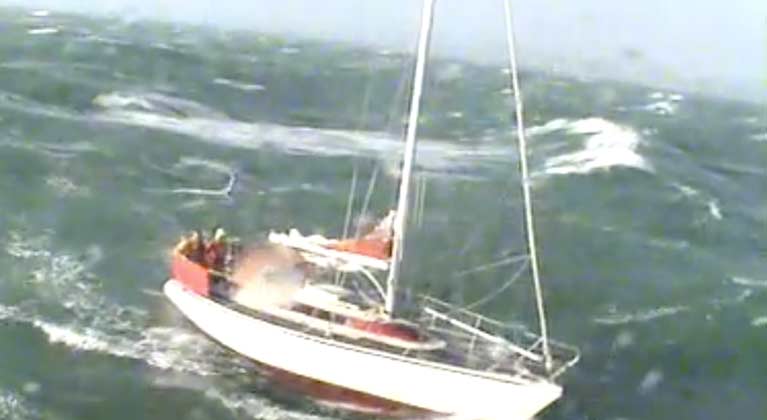 Conditions were extremely challenging with force nine winds with a six metre sea swell when Rosslare RNLI went to rescue this yacht in the Irish Sea
Conditions were extremely challenging with force nine winds with a six metre sea swell when Rosslare RNLI went to rescue this yacht in the Irish Sea
Finally, there’s the episode of that rescue by the Rosslare Lifeboat of a yacht in distress at the height of the storm. Some day we’ll learn just how the yacht was there at all, for heaven knows Ophelia had been well signaled for days in advance. But oddly enough, that’s not too important this morning, What is important is that Cox’n Eamonn O’Rourke and his crew – all volunteers – were assembled within minutes, they carried out a text-book rescue with clinical precision, and the country could return to keeping itself safe for the day, as we’d been advised to.
Because although there’d been some grumblings that the warnings beforehand were surely tending towards exaggeration, they weren’t. The three tragic deaths were three deaths too many, and infinitely sad. But yesterday could have been a continuing litany of personal tragedies if people had deluded themselves that they could have got away with cheating such a prodigious force of nature.
So we emerge from our encounter with Storm Ophelia with a heightened sense of ourselves as a mature nation. Ireland is unique – a medium-sized island on the leeward side of one of the roughest oceans in the world. Our population is such that we have to stretch resources to provide the services and expertise which countries with larger populations can take in their stride.
Yet when Storm Ophelia tested those services, Ireland was not found wanting. And we Irish conducted ourselves like sensible adults who will accept a certain amount of discipline when it is presented to us in a competent and reasonable manner.
On this, the day after the storm, we can feel quietly proud of being Irish.
Larne & Bangor Lifeboats Answer Pager Call During Storm Ophelia
#RNLI - Both Larne and Bangor RNLI were requested to launch last night (Monday 16 October) by Belfast Coastguard during Storm Ophelia.
The volunteer lifeboat crew pagers sounded at 9.25pm following reports of a person in the water at Whitehead off the Antrim coast.
Sea conditions at the time were very rough with winds gusting up to 60mph (97kmh).
As the Larne RNLI crew assembled and made preparations to leave the Port of Larne, Belfast Coastguard cancelled the launch following confirmation from the PSNI that two women were ashore safe and well.
Larne Coastguard, Portmuck Coastguard and the PSNI were also tasked to the incident.
Speaking later, Larne RNLI Coxswain Frank Healy said: “During what is extremely challenging weather conditions, I am proud to say 18 volunteers answered the call immediately. This demonstrates our crew dedication to help those in distress at sea.
“Our volunteer lifeboat crews will always launch to rescue those in danger at sea, but to launch into conditions like these could also put their lives at risk.
“I strongly urge people to respect the water and stay away from the coastline during the storm. If you do see someone else in trouble in the water, call 999 and ask for the coastguard. Don’t enter the water yourself as you could also end up in serious danger.”
#Ophelia - Windsurfers on the Louth coast have been roundly criticised on social media as they prompted a major rescue operation before the arrival of Storm Ophelia, as TheJournal.ie reports.
The four windsurfers, originally thought to be kitesurfers, made their own way to shore after getting 'into difficulty' this morning — but not before Clogherhead RNLI, Greenore Coast Guard and the Dublin-based Irish Coast Guard rescue helicopter had launched to their location, off Blackrock in Dundalk Bay.
The Irish Coast Guard has repeated widespread calls to stay away from the coast during the current storm conditions throughout Ireland.
2 kite surfers safely escorted to shore with @GreenoreCG, @ClogherheadRNLI, Rescue116 and local Garda present@TOTTDundalk @rtenews pic.twitter.com/fss1F91cVx
— Carlingford (@CarlingfordIRE) October 16, 2017
This article was changed to correct an error in the number of windsurfers involved in this morning's incident.
Status Red Weather Warning For Monday As Ophelia Closes In
#Ophelia - Met Éireann has issued a Status Red wind warning for southern and western counties as the remnants of Hurricane Ophelia are set to bring gusts of more than 130kmh this Monday 16 October.
Mean wind speeds in excess of 80kmh have the potential for causing structural damage and disruption in Galway, Mayo, Clare, Cork and Kerry, with dangerous marine conditions off the South and West Coasts from Monday morning till the small hours of Tuesday 17 October.
A Status Orange weather warning is in effect for the rest of the country with means winds between 65 and 80kmh, particularly in coastal counties.
Dun Laoghaire Marina has already issues a caution to its berthholders to ensure sufficient fendering and strong mooring warps are in place at the country’s largest marina.



























